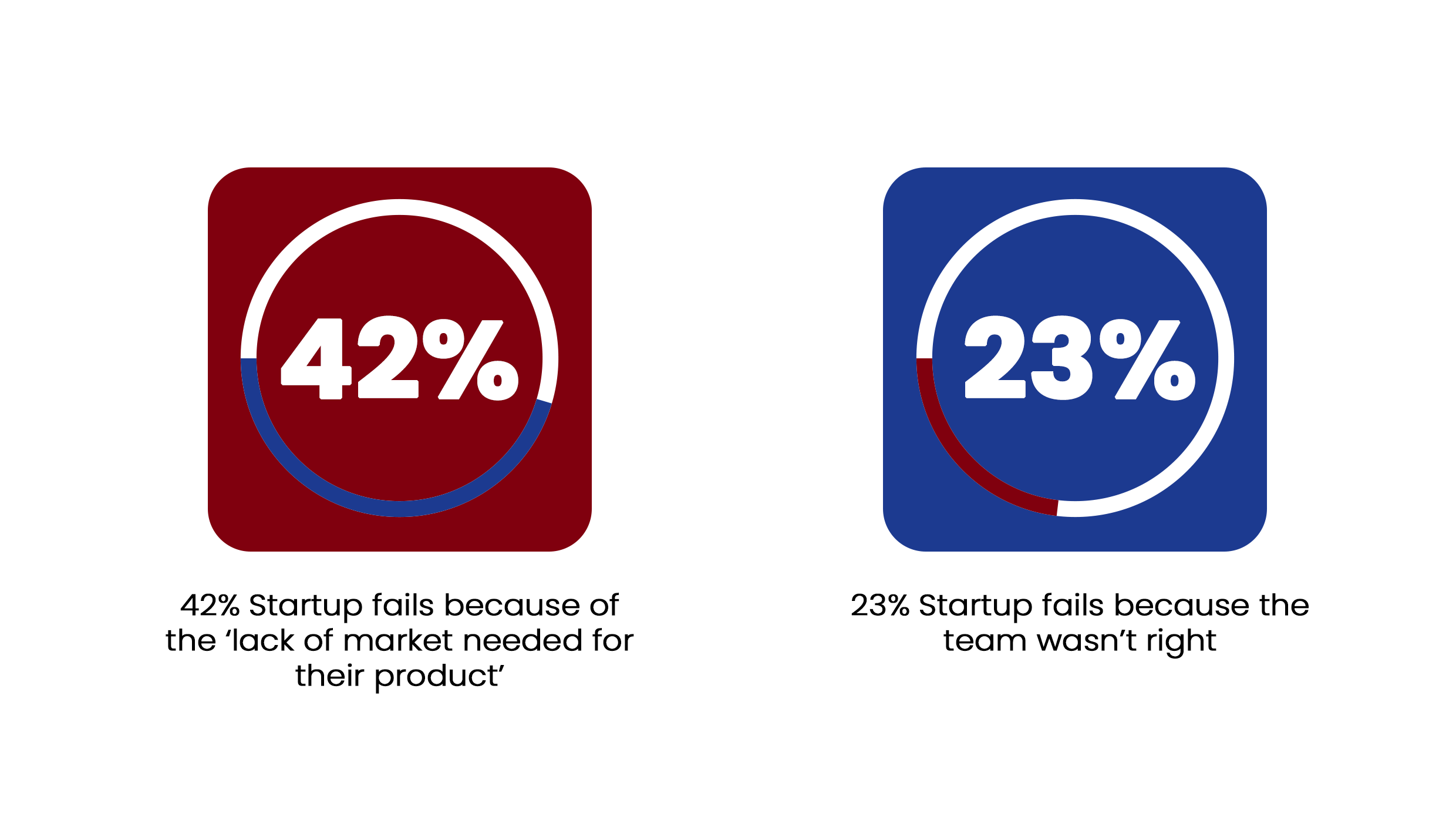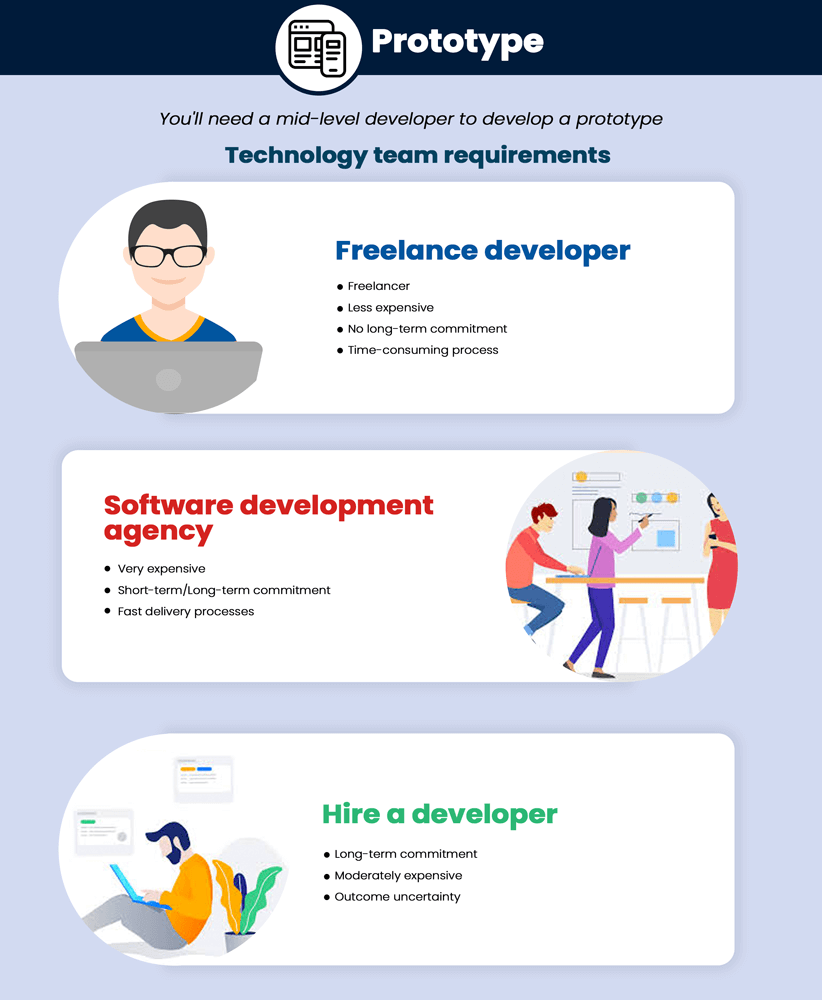
12 Jun How to Build a Technology Team That Wont Sink Your Startup
Working for a startup is challenging. Every team member is required to give their 100%. Startups can’t delay launching their products and entering the market, especially when funding is on the line and stakeholders are watching. This is why a startup founder should give 200% in building a startup team that will ensure the success of the project.
But, do you need a technical co-founder to start a tech startup? There are several examples of successful entrepreneurs who made it without a tech-savvy partner.
What entrepreneurs, however, cannot do without is analyzing the market need for the product. 42% of startups fail because of the ‘lack of market needed for their product’. This brings us to the importance of putting together the pieces needed for a successful startup.
There are several stages in a tech startup’s journey to become successful. In some of these stages, you can get by without hiring a technology expert.

Here are some stages of your startup and technology backup you need in each stage.
Developing a proof of concept
A proof of concept (PoC) assesses the viability of a software product for solving a business need. That’s a fancy way of saying it tests to see whether an idea will work.
The concept part of the PoC consists of the basic framework for the software solution. It’s not fully fleshed out or completed yet; it’s just the bare bones needed to decide whether you can move forward or must make changes.
You don’t need to hire a CTO at this stage.
You can take the help of a technology consultant or an external agency for guidance and to validate your idea.
A technology consultant is someone with close to 15-25 years of experience in software development. While you can benefit from the wealth of their experience; it won’t be worthwhile to keep such expensive professionals on your payroll at the initial stage.
A consultation is a contract–based or hourly commitment, which will get the job done for you.
You will need more market research during this phase than you need a developer.
The technology expert might be able to tell you whether your idea is feasible from a technology standpoint and lay out a path which you need to take. They’ll guide you on the platforms and developers you will need once you start the development process.

Developing a prototype
A prototype is not expected to have all the features and functions of a market-ready product, nor is it expected to contain all the usability or aesthetics of a final product. It gives stakeholders and potential investors a draft of what the final product would be.
You will be able to develop a prototype with the help of a developer, based on the guidance from a technology expert. If you intend to build a software development team to work on your products, this would be the right time to hire one experienced developer.
But, If your core business function is not software and none of your partners have a technology background, it’s always better to go for a less expensive and efficient option of hiring a software development agency.
Since a prototype does not need complex features, you might be able to develop it with just the help of a developer. You can hire a freelancer, take help from a software development company or hire a developer to work for you during this stage.

Developing a Minimum Viable Product
A minimum viable product, or MVP, is a ready-to-launch product version with enough features to attract early adopters in the market. The MVP will help you to validate your product idea from the feedback you receive from the market. In industries such as software, the MVP can help the product team receive user feedback as quickly as possible to iterate and improve the product.
Although your product is minimally viable at this stage, you wouldn’t have to start again from scratch when you need to scale up and expand. You must be able to develop a better version of the product by adding new features and interface changes to your MVP.
In-order to do this, you will need to use scalable technologies, platforms and architecture while developing an MVP. This will ensure that you don’t have to start again when you need product modifications later.
Do not develop an MVP without the guidance and monitoring of a technology expert. As this will cost you dearly in the later stages. You need the guidance of someone who has a 360-degree overview of the technology landscape. If you hire a mid-level software developer to develop your MVP, he will choose a programming language and platform which he is more comfortable with than one that really suits your current and future business needs. This can backfire at later stages when you realize you’ve spent all your time and money in developing a product that is not scalable beyond a certain point.
An experienced technology expert can analyse your product requirements, features and scope to suggest the right technology stack that must be used to ensure the scalability, maintenance, performance and efficiency of your product. It will be much easier to modify your product and add on new features. This way you will not run into any technology roadblocks
While creating an MVP, you need an experienced technology expert to oversee the development process and a team of developers trained to work with your technology stack.
One of the options is hiring a CTO and a development team at this stage, but it will be highly expensive. And if the team you built is not competent enough, the project can get delayed.
You can otherwise hire an enterprise software development agency at this stage, but you will have very little control over the development process and it would be difficult to accommodate any modifications once the development starts.
Another option is hiring a dedicated software development team during this stage, which is cost-efficient and gives you better control over the project. You’ll have the freedom to suggest modifications to your product and follow agile development processes allowing you to be in constant contact with the people working on your project. There will be an experienced technology expert to oversee the development process.
If you are not sure about whether to outsource your software requirements or to build your own software development team, ask yourself these questions.

Scaling, Modifying and Maintaining your Product
Once you have successfully launched your MVP in the market and starts receiving user feedback, the next stage is scaling up from MVP and launching a better version.
The user feedback will help you to identify modifications that you may have never planned for.
You will need to double down the user experience and add on more features.
You will need to define KPIs to analyze the user behaviors for your product.
You will have to invest in product development and product management at this stage.
This is the ideal time to decide whether you need to build a development team exclusively to work on your product or partner with a dedicated team service or other software development agencies in the long run.
Consider the following factors while you make this decision,
- Determine whether your business can benefit from outsourcing
- Consider different funding cycles and processes
- Consider speed and quality of resourcing
- Weigh the pros and cons of in-house teams: They guarantee the availability of teams but at a cost
- Consider the benefits of outsourcing: It offers cost-effectiveness but may introduce communication barriers
- Evaluate your options for outsourced partners before deciding

If you consider all these facts prior to making a decision, you will be able to choose a comfortable, cost effective and efficient way to develop you product.
Are you looking for an experienced IT team to help with your startup?
Take advantage of our free consultation service to discuss your startup idea with a technology expert who has 25 years of industry experience. We have a panel of technology experts and a wide range of startup IT solutions that will help startups to save a lot of time and money. Let us help you to take your product to market with it’s full potential.

